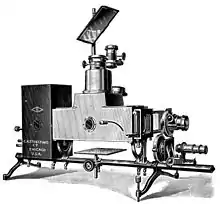Carlos Ruiz peleando con un cochero
Carlos Ruiz peleando con un cochero (English: Carlos Ruiz fighting with a coachman) is a Venezuelan proto-Western and slapstick comedy film created by and starring Carlos Ruiz Chapellín and Ricardo Rouffet. It was first played in the Circo Metropolitano de Caracas on 26 November 1897.[1][2][3]
| Carlos Ruiz peleando con un cochero | |
|---|---|
| Directed by | Ricardo Rouffet |
| Produced by | Carlos Ruiz Chapellín |
Release date |
|
| Country | Venezuela |
Background

Ruiz was a showman by trade, and rented the Circo Metropolitano to show zarzuelas and circus variety shows as well as films. In 1897, after the release of the first Venezuelan films in Maracaibo, Ruiz went into business with Ricardo Rouffet to create their own films.[4] He had several contracts with figures including W. O. Wolcopt with a Projectoscope[5] and Gabriel Veyre with a Cinematograph to show films at the Circo.[6] Wolcopt then traveled around the country and Veyre left to Colombia before Carlos Ruiz peleando... was released, but his Cinematograph, which could both record and project film, may have been used to make Ruiz' films.[2]
Azuaga García describes Ruiz' choice to hold film showings in a circus as "gaudy", as the previous screenings were held in spectacular theatres and halls, but also suggests it was Ruiz' attempt to "truly bring cinema to the popular classes".[7]
Film screening and content
In November 1897, advertisements in Caracas start promoting "the new Projectoscope", claiming it played in color, and "criollo views", referring to the pair of films made by Venezuelans Ruiz and Rouffet. They also claimed that they would be the first Venezuelan-made films to play in the capital.[1]
In the film, Ruiz as a character gets into a stagecoach heist and a fight with its coachman; Azuaga García notes that the devised situation makes this film an early attempt at narrative staging.[7] Despite the fictional scenario, the films may have been advertised to the French as showing "real things" from life in the Caracas area.[8][9]
Sueiro Villanueva proposes that Rouffet was the film's active director, but also proposes that someone else altogether could have handled the camera, acting as director but staying absent from the public screenings.[1] Details on neither Rouffet nor the films were published in the local press, suggesting that it was critically overlooked.[10]
References
- Sueiro Villanueva 2007, p. 71.
- Serrano.
- de Miranda 2019.
- Serrano 10 November 2014.
- Sueiro Villanueva 2007, p. 61.
- Sueiro Villanueva 2007, p. 69–70.
- Azuaga García 2015, p. 30.
- Sueiro Villanueva 2007, p. 72.
- Azuaga García 2015, pp. 32–37.
- Sueiro Villanueva 2007, p. 71–72.
Sources
- Literature
- Sueiro Villanueva, Yolanda (2007). Inicios de la exhibición cinematográfica en Caracas (1896-1905) [Beginnings of the cinema exhibition in Caracas (1896-1905)] (in Spanish) (1 ed.). Caracas: Fondo Editorial de Humanidades y Educación, Universidad Central de Venezuela. ISBN 978-9800023952. OCLC 225867560.
- Serrano, Arturo. "The Beginnings of Cinema in Venezuela: The arrival of Cinema in Venezuela (1896–1907)". Universidad Católica Andrés Bello. Retrieved 14 December 2018. Cite journal requires
|journal=(help) - Filmografía 1897-1938 [Filmography 1897-1938] (in Spanish). Fundación Cinemateca Nacional. 1997. ISBN 980-074532-7.
- Azuaga García, Jesús Ricardo (September 2015). Pandemonium: La Filmografia de Roman Chalbaud en el Cine Venezolano: Contexto y Analisis [Pandemonium: The Filmography of Roman Chalbaud and the Cinema of Venezuela] (PDF) (Thesis) (in Spanish). Universitat de Valencia.
- Web
- Serrano, Arturo (10 November 2014). "Los heroes del cine venezolano (Parte I)" [The heroes of Venezuelan cinema (Part 1)]. Vice Versa (in Spanish). Retrieved 13 September 2019.
- de Miranda, Nancy (2019). "Cronología del Cine Venezolano" [Chronology of Venezuelan Cinema] (in Spanish). Observatorio Cine.